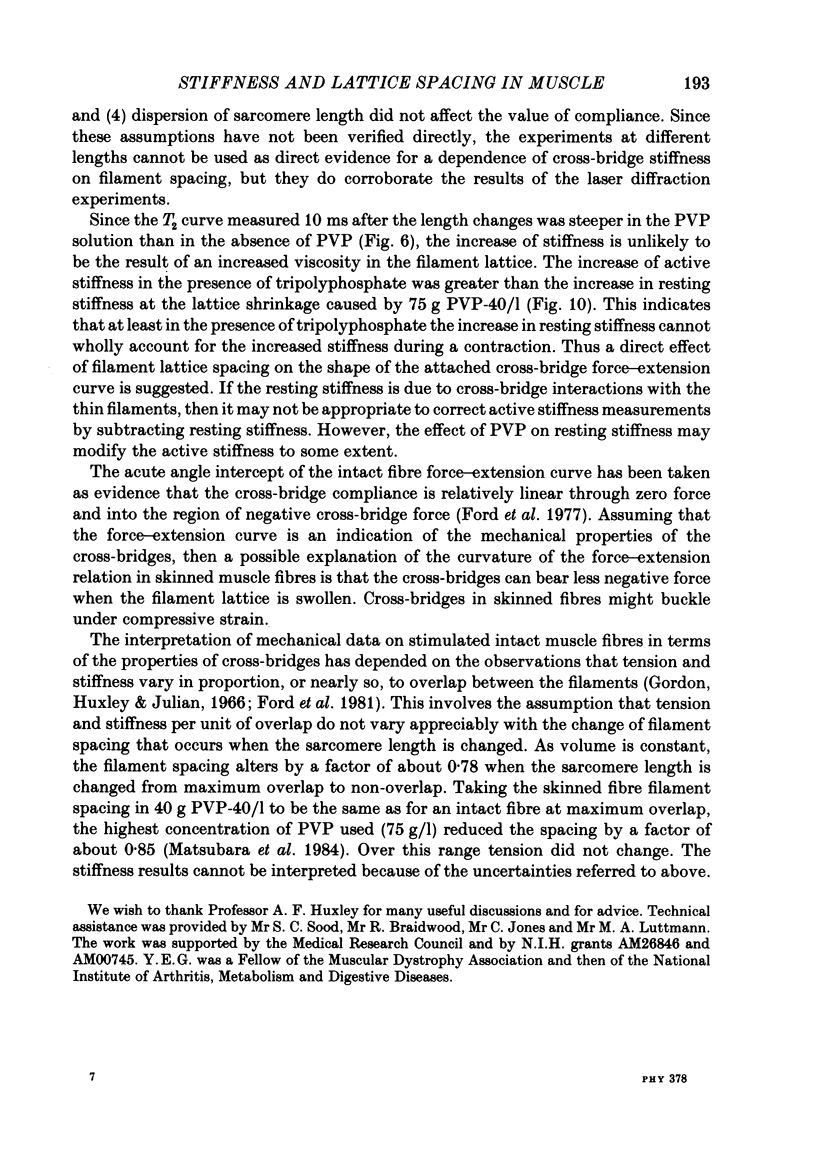Abstract
When the surface membrane is removed from a frog muscle fibre the myofibrils swell, so that the spacing between the filaments increases by 10-30%. In this study, the stiffness of skinned fibres was measured when the lateral spacing of the filament lattice was reduced osmotically using polyvinyl pyrrolidone (PVP), a synthetic linear polymer. In the absence of PVP, the apparent stiffness of relaxed skinned fibres measured during ramp stretches was about 0.05-0.1 of the stiffness of intact fibres. The stiffness increased when the lattice spacing was decreased. The mechanical characteristics of resting stiffness in the presence of PVP (or bovine serum albumin) were similar to those of the short-range elastic component of resting intact fibres. However, when the spacing of skinned fibres was reduced osmotically to that of the intact lattice, the stiffness of skinned fibres was about 1.6 times higher. In the absence of PVP, Ca2+-activated skinned fibres were less stiff than are fully active intact fibres during isometric tetani. The skinned fibre force-extension relation was markedly curved. As the filament spacing was reduced, the stiffness of the Ca2+-activated skinned fibres increased, with little change in isometric tension, and the force-extension curve became more linear. Experiments at varied filament overlap and during feed-back control of sarcomere length, monitored by laser diffraction, showed that PVP increased the stiffness of the sarcomeres. The increase of active stiffness in the presence of PVP could be partially dissociated from the increase of resting stiffness by inclusion of Mg tripolyphosphate in the bathing solutions. It is concluded that the low stiffness and the non-linearity of the force-extension curve observed in fully activated skinned fibres are due primarily to the increase of filament separation that occurs when a fibre is skinned. The mechanism may be related to an increased angle between the subfragment-2 part of the cross-bridge and the backbone of the thick filament, perhaps leading to buckling of cross-bridges under compression.
Full text
PDF



















Selected References
These references are in PubMed. This may not be the complete list of references from this article.
- Ferenczi M. A., Goldman Y. E., Simmons R. M. The dependence of force and shortening velocity on substrate concentration in skinned muscle fibres from Rana temporaria. J Physiol. 1984 May;350:519–543. doi: 10.1113/jphysiol.1984.sp015216. [DOI] [PMC free article] [PubMed] [Google Scholar]
- Ford L. E., Huxley A. F., Simmons R. M. Tension responses to sudden length change in stimulated frog muscle fibres near slack length. J Physiol. 1977 Jul;269(2):441–515. doi: 10.1113/jphysiol.1977.sp011911. [DOI] [PMC free article] [PubMed] [Google Scholar]
- Ford L. E., Huxley A. F., Simmons R. M. The relation between stiffness and filament overlap in stimulated frog muscle fibres. J Physiol. 1981 Feb;311:219–249. doi: 10.1113/jphysiol.1981.sp013582. [DOI] [PMC free article] [PubMed] [Google Scholar]
- Goldman Y. E., Simmons R. M. Control of sarcomere length in skinned muscle fibres of Rana temporaria during mechanical transients. J Physiol. 1984 May;350:497–518. doi: 10.1113/jphysiol.1984.sp015215. [DOI] [PMC free article] [PubMed] [Google Scholar]
- Gordon A. M., Huxley A. F., Julian F. J. The variation in isometric tension with sarcomere length in vertebrate muscle fibres. J Physiol. 1966 May;184(1):170–192. doi: 10.1113/jphysiol.1966.sp007909. [DOI] [PMC free article] [PubMed] [Google Scholar]
- Haugen P., Sten-Knudsen O. The dependence of the short-range elasticity on sarcomere length in resting isolated frog muscle fibres. Acta Physiol Scand. 1981 Jun;112(2):113–120. doi: 10.1111/j.1748-1716.1981.tb06793.x. [DOI] [PubMed] [Google Scholar]
- Hill D. K. Tension due to interaction between the sliding filaments in resting striated muscle. The effect of stimulation. J Physiol. 1968 Dec;199(3):637–684. doi: 10.1113/jphysiol.1968.sp008672. [DOI] [PMC free article] [PubMed] [Google Scholar]
- Lännergren J., Noth J. The effect of bathing solution tonicity on resting tension in frog muscle fibers. J Gen Physiol. 1973 Dec;62(6):737–755. doi: 10.1085/jgp.62.6.737. [DOI] [PMC free article] [PubMed] [Google Scholar]
- Lännergren J. The effect of low-level activation on the mechanical properties of isolated frog muscle fibers. J Gen Physiol. 1971 Aug;58(2):145–162. doi: 10.1085/jgp.58.2.145. [DOI] [PMC free article] [PubMed] [Google Scholar]
- Matsubara I., Goldman Y. E., Simmons R. M. Changes in the lateral filament spacing of skinned muscle fibres when cross-bridges attach. J Mol Biol. 1984 Feb 15;173(1):15–33. doi: 10.1016/0022-2836(84)90401-7. [DOI] [PubMed] [Google Scholar]
- Moisescu D. G. Kinetics of reaction in calcium-activated skinned muscle fibres. Nature. 1976 Aug 12;262(5569):610–613. doi: 10.1038/262610a0. [DOI] [PubMed] [Google Scholar]
- Moss R. L., Sollins M. R., Julian F. J. Calcium activation produces a characteristic response to stretch in both skeletal and cardiac muscle. Nature. 1976 Apr 15;260(5552):619–621. doi: 10.1038/260619a0. [DOI] [PubMed] [Google Scholar]


